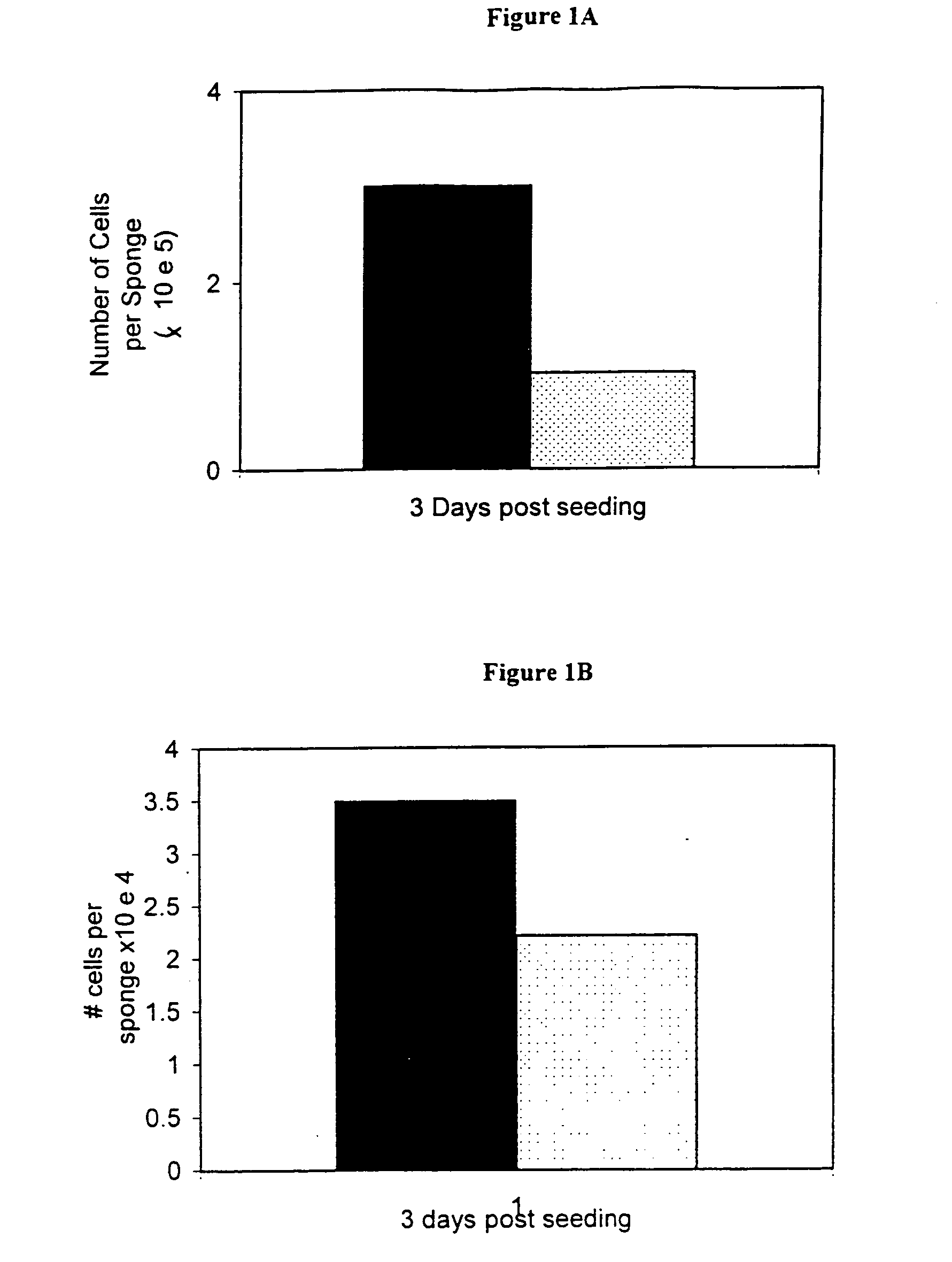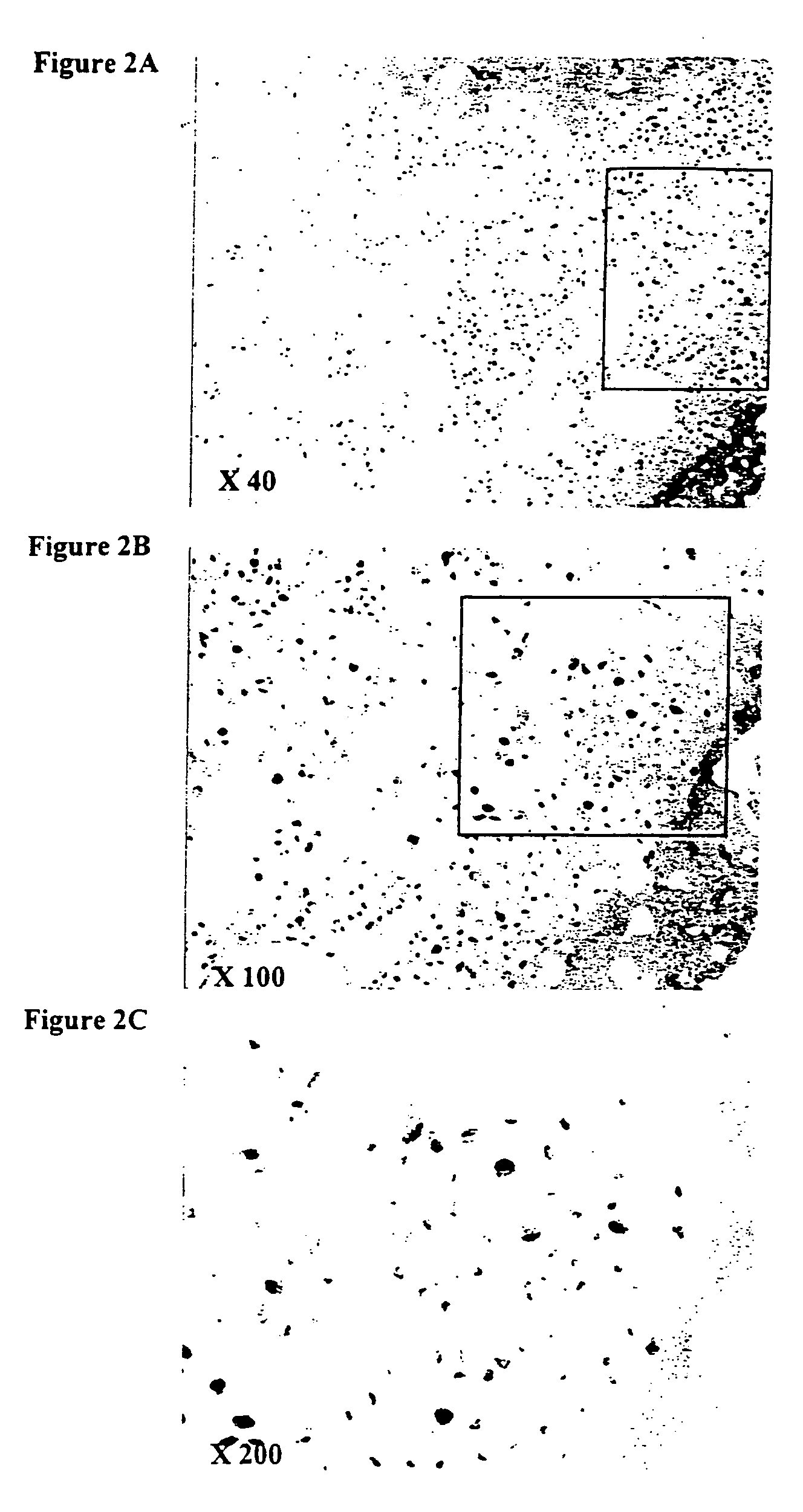Freeze-dried fibrin matrices and methods for preparation thereof
a fibrin matrix and freeze-dried technology, applied in the field of freeze-dried biomatrices, can solve the problems of short-lived clinical improvement, reduced function, damage to cartilage, etc., and achieve the effects of improving cell incorporation capacity, improving cell absorption ability, and maintaining viability
- Summary
- Abstract
- Description
- Claims
- Application Information
AI Technical Summary
Benefits of technology
Problems solved by technology
Method used
Image
Examples
example 1
Preparation of a Fibrin Matrix
[0176] Although detailed methods are given for the preparation of the plasma protein, it is to be understood that other methods of preparing plasma proteins are known in the art and are useful in the preparation of the matrix of the present invention. A non-limiting example of a protocol for the preparation of a fibrinogen-enriched solution is given in Sims, et al. (Plastic & Recon. Surg. 101:1580-85, 1998). Any source of plasma proteins may be used, provided that the plasma proteins are processed to be substantially devoid of anti-fibrinolytic agents, plasminogen and of organic chelating agents Examples of plasma protein preparation methods are given in examples 2 and 3, hereinbelow.
[0177] Materials and Methods:
[0178] Source of plasma proteins e.g. Plasminogen-free fibrinogen (Omrix, Ill.) approximately 50-65 mg / ml stock solution.
[0180] Thrombin (1000 International Units / ml, Omrix, Ill.)
[0181] Optional: Hyaluronic acid...
example 2
Isolation of Partially Purified Plasma Proteins from Whole Plasma
[0187] Plasma protein may be prepared from different sources such as fresh plasma, fresh frozen plasma, recombinant proteins and xenogeneic, allogeneic or autologous blood. The fresh frozen plasma was received from the blood bank (Tel-Hashomer, Israel). The plasma (220 ml) was thawed in a 4° C. incubator over night, followed by centrifugation at 4° C. at approximately 1900 g for 30 min. The pellet was resuspended in 2.5 ml PBS with gentle rolling until a homogenized solution was seen. The total protein concentration may be estimated by Bradford assay and SDS-PAGE (comparing to a standard). Exemplary samples were found to be about 42 mg total protein / ml to about 50 mg total protein / ml. The plasma may further be treated to remove plasminogen, using methods known in the art. Non-limiting examples of methods useful for removing plasminogen from blood or blood derivates such as plasma or a cryoprecipitate are disclosed in ...
example 3
Extraction of Plasma Protein Fractions from Allogeneic or Autologous Blood
Materials:
[0190] 1) Sodium citrate, 3.8% or any other pharmaceutically acceptable anti-coagulant [0191] 2) Ammonium sulfate (NH4)2SO4, saturated (500 g / l) [0192] 3) Ammonium sulfate (NH4)2SO4, 25% [0193] 4) Phosphate-EDTA buffer: 50 mM phosphate, 10 mM EDTA, pH 6.6 [0194] 5) Tris-NaCl buffer: 50 mM Tris, 150 mM NaCl, pH 7.4 [0195] 6) Ethanol, absolute 4° C. [0196] 7) Whole blood (Israel Blood Bank, Tel Hashomer Hospital or from patient)
Methods:
[0197] This method may be used to produce plasma proteins that may be treated for removal of plasminogen by methods known in the art, including affinity chromatography. The plasma proteins are isolated according to standard methods. To one 450 ml bag of blood from the blood bank, containing sodium citrate, 50 ml of a 3.8% sodium citrate solution was added and the solution was mixed gently.
[0198] The blood-sodium citrate was centrifuged at 2,100 g for 20 min. The s...
PUM
| Property | Measurement | Unit |
|---|---|---|
| concentration | aaaaa | aaaaa |
| concentration | aaaaa | aaaaa |
| concentration | aaaaa | aaaaa |
Abstract
Description
Claims
Application Information
 Login to View More
Login to View More - R&D
- Intellectual Property
- Life Sciences
- Materials
- Tech Scout
- Unparalleled Data Quality
- Higher Quality Content
- 60% Fewer Hallucinations
Browse by: Latest US Patents, China's latest patents, Technical Efficacy Thesaurus, Application Domain, Technology Topic, Popular Technical Reports.
© 2025 PatSnap. All rights reserved.Legal|Privacy policy|Modern Slavery Act Transparency Statement|Sitemap|About US| Contact US: help@patsnap.com



